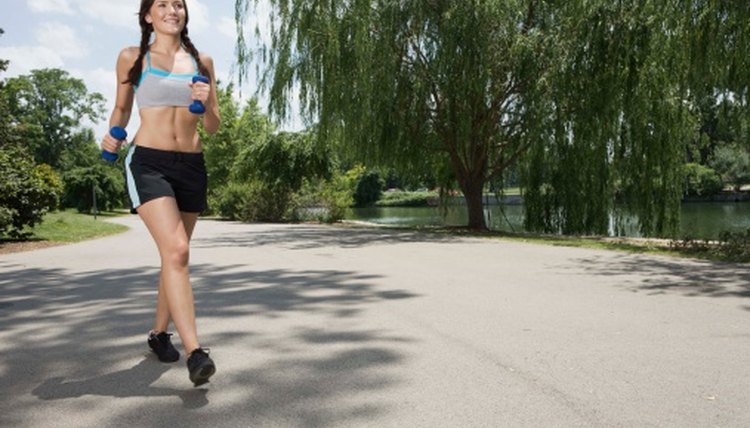Common Problems With Running Shoes & Holes in the Mesh

Running for sport or fitness requires the correct shoes. Keeping your shoes in good repair will reduce the likelihood of shoe failure while you’re running. Make sure you have the right shoe for your foot and inspect your running shoes prior to running so you can make any repairs. Shoes that are beyond repair can be recycled so they don't take up landfill space.
Shoe Fit
Wearing a shoe that is too big, too small, too narrow or too wide may impede your success while running. Not only do you open yourself to accidents caused by tripping and falling, but your foot may not appreciate the ill fit. There are some components to a running shoe that should be important to every runner: shoe flexibility, ankle support, shock absorbency, fabric breathability and shoe weight. Consumer Reports maintains that the wrong shoe for your foot can result in joint difficulties and foot pain. The magazine website recommends shopping for running shoes in late afternoon when your foot is slightly larger due to swelling from daily activity. Also, bring the socks you would normally wear while running so you can get the right “feel” of the shoes you are trying on. Always try on running shoes before making a purchase so you can practice running and possibly get advice from the sales staff.
Distinguishing Between Running Shoes and Other Shoe Types
Unlike Shakespeare’s rose by any name, all shoes are not the same. Running shoes differ from walking, basketball and other sports shoes. Consumer Reports says a runner’s foot impacts the ground at a force of up to three times the runner's body weight. Because of this impact upon the muscles and bones of the foot, it is important to buy running shoes designed to help absorb that impact and lessen the stress. Running shoes feature cushioning in areas of the shoe sole and insole most likely to make impact with the ground. Soles will feature traction for gripping all ground surfaces during running. Other shoes, such as basketball or football shoes, may have soles intended for gripping slick or rough surfaces as dictated by the sport for which the shoe is intended.
Sole, Insole and Shoe Lace Problems
Before running, inspect the shoe for damage. Damaged running shoes should be repaired. The sole is constructed of rubber variations. A loose sole can be repaired by applying a silicone-based or polyurethane-based adhesive between the sole and the shoe. Secure the sole to the shoe while the glue is drying with rubber bands or tape. These type of adhesives require up to 72 hours of drying and curing before the shoe can be worn again, so you may need to use a backup pair of running shoes. Insoles that have disintegrated or bunched up may be removed and replacement insoles inserted. Make sure the replacement does not move around. Shoe laces have a tendency to get dirty, unravel, rip and break. Shoe laces can be removed from the shoe and washed in the washing machine in a lingerie bag or tied into a sock. Dry the shoe laces in the clothes dryer or hang to dry. Replacement shoe laces are available at grocery, discount and shoe stores and it’s a good idea to keep a spare pair so you don’t find yourself with broken laces when you need to go running.
Holes In Mesh Panels
Many running shoes feature mesh fabric side panels, sometimes on the tongue, and sometimes on the entire shoe upper. Mesh that gets snagged, ripped or punctured can form holes. To fix a hole in the mesh of a running shoe, purchase adhesive tent or shoe mesh repair patches. Cut the patches to fit and adhere them over the hole according to the manufacturer’s recommendations. Mesh repair patches are also available as heat transferred patches and are applied with an iron, but these patches can be difficult to iron on due to the shape of the running shoe. You can use a small crafting or quilting iron to iron the patches to a shoe.
References
- Malisoux L, Ramesh J, Mann R, Seil R, Urhausen A, Theisen D. Can parallel use of different running shoes decrease running-related injury risk?. Scand J Med Sci Sports. 2015;25(1):110-5. doi:10.1111/sms.12154
- Vincent HK, Vincent KR. Five key characteristics to consider when purchasing a running shoe. Curr Sports Med Rep. 2015;14(5):358. doi:10.1249/JSR.0000000000000185
Writer Bio
Louise Harding holds a B.A. in English language arts and is a licensed teacher. Harding is a professional fiction writer. She is mother to four children, two adopted internationally, and has had small businesses involving sewing and crafting for children and the home. Harding's frugal domestic skills help readers save money around the home.
